When ordering bulk warning labels for static-sensitive work areas, you'll need to meet specific ESD safety standards. Your labels must feature black symbols on yellow backgrounds and include proper handling instructions. For unit packs, use labels that comply with ASTM D 5445 standards, while intermediate containers need 2" x 2" labels and exterior containers require 4" x 4" labels. You'll want durable, moisture-resistant materials like vinyl or semi-gloss litho for longevity. Place labels at workstation entrances, material handling zones, and eye-level equipment access points. Understanding the complete requirements will guarantee your facility maintains proper ESD protection protocols.
Understanding ESD Warning Label Requirements
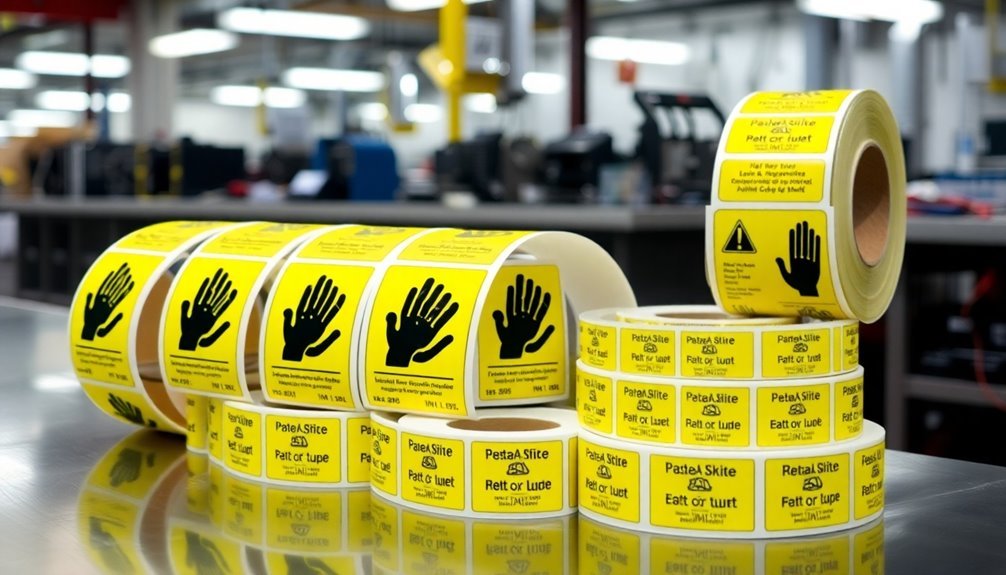
ESD warning labels must comply with strict standards set forth in MIL-STD-129 and ANSI S8.1 requirements. You'll need to guarantee your labels feature the black on yellow background color scheme and include proper handling instructions for static-sensitive devices. Additional marking requirements may be specified in your contract or by the cognizant activity.
The labels must clearly display either the ESD susceptibility symbol (triangle with a slashed hand) or the ESD protective symbol (triangle with hand and surrounding arc), depending on your specific application.
When you're labeling containers, you'll need to follow specific size requirements: 2" x 2" for intermediate containers and 4" x 4" for exterior containers. Your labels must be readable from three feet away and include the phrase "ATTENTION STATIC SENSITIVE DEVICES" along with "HANDLE ONLY AT STATIC SAFE WORK STATIONS."
For unit packs, you'll need to place labels that clearly identify the ESDS devices inside.
To maintain compliance, you should use "NOTICE" as your signal word, following ANSI Z535 standards. Remember that your labels must provide sufficient contrast and blank space to guarantee readability, and they should harmonize with international IEC standards by incorporating globally recognized ESD symbols.
Types of Static Warning Labels
Your facility's static warning system will benefit from color-coded labels that use industry-standard yellow and black or orange and black combinations to maximize visibility.
You'll need to implement floor marking labels strategically at entry points and throughout static-controlled areas to guide workers and visitors. While installing labels, consider using a fadeIn animation to gradually introduce new warning signage, making them more noticeable to personnel.
When placing equipment warning stickers, you should position them prominently on tools, workstations, and storage containers where they'll be immediately visible during handling.
Color-Coded Alert Systems
The development of color-coded alert systems in static warning labels follows a standardized approach across the industry. You'll find that yellow and black combinations dominate the static warning landscape, serving as the primary colors for caution labels that alert you to potential physical hazards. ANSI Z535.4 guidelines ensure these labels effectively communicate hazards and safety precautions.
While other industrial warning colors like orange, red, blue, and green have specific purposes, they're not typically used for ESD warnings.
When working with static-sensitive equipment, you'll want to familiarize yourself with these key color-coding principles:
- Yellow backgrounds with black text indicate caution areas and serve as your primary visual alert for static-sensitive zones
- Black symbols, particularly the Triangle with reaching hand designs, mark both ESD susceptibility and protective measures
- White backgrounds often complement these designs to maximize visibility and contrast
Understanding these color codes helps you quickly identify static hazards and protective measures in your workspace. The consistency in color usage across static warning labels makes it possible for you to immediately recognize potential risks, whether you're handling sensitive components or entering protected areas.
This standardization is essential for maintaining effective ESD control programs and protecting sensitive equipment.
Floor Marking Label Options
Building on established color standards, floor marking labels represent a vital component of static warning systems. You'll find these labels available in various sizes, with common dimensions including 4 x 4 inches and 2 x 2 inches, allowing you to choose the most appropriate option for your specific area requirements.
When selecting floor marking labels, you'll want to focus on durability and visibility. The most effective options feature bright colors, particularly yellow, to guarantee immediate visibility in busy work environments. Clear messaging must be incorporated with easy-to-read text and bold graphics to maximize safety communication.
They're manufactured using moisture-resistant materials like semi-gloss litho, guaranteeing they'll withstand frequent foot traffic and cleaning procedures.
You can source these labels from several reliable suppliers. Uline and United ESD offer standard adhesive-backed options that comply with ANSI/OSHA standards and ESD S20.20 requirements.
If you need custom solutions, suppliers like Superior Mark can create specialized floor markers that meet your facility's specific needs. When applying these labels, you'll want to strategically place them at entry points to static-sensitive areas and around critical equipment.
The labels' strong adhesive backing guarantees they'll remain securely in place while effectively communicating essential static precautions to your workforce.
Equipment Warning Sticker Placement
Within static-controlled environments, proper placement of warning stickers serves as a crucial first line of defense against ESD damage. You'll need to guarantee your equipment warning labels are clearly visible and strategically positioned to maximize awareness among workers and visitors.
When applying ESD warning stickers to equipment, focus on using the correct symbols that match your specific static control requirements, whether they're ESD susceptibility symbols or ESD protective symbols. The labels' 3 x 2 inch size provides optimal visibility while maintaining a professional appearance on equipment surfaces.
For effective equipment warning sticker placement, follow these key guidelines:
- Position labels at eye level on equipment surfaces where they're immediately noticeable during normal operation or maintenance, complying with ANSI/ESD S8.1 standards.
- Apply stickers near access points, control panels, and areas where workers commonly interact with the equipment to reinforce ESD awareness.
- Use durable adhesive-backed labels that can withstand your specific environmental conditions and temperature ranges.
Remember to check that your warning stickers maintain their integrity over time and don't become obscured by dirt or wear. If you're using reusable labels, guarantee they're properly secured each time equipment is accessed or serviced, and replace any damaged or illegible stickers promptly to maintain effective ESD control.
Proper Label Placement Guidelines
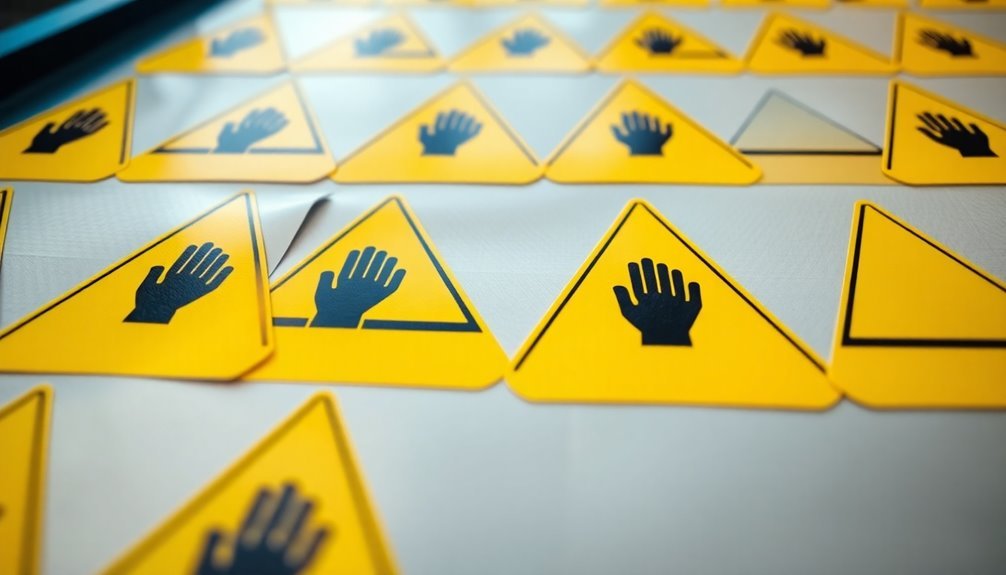
You'll want to position your ESD warning labels in strategic high-traffic areas where personnel are most likely to encounter static-sensitive devices or enter protected zones.
Your labels must be clearly visible from at least three feet away to guarantee workers can read the warnings before handling sensitive components.
Make sure to place labels at workstation entrances, material handling zones, and equipment access points where static discharge risks are highest.
Consider using labels made with UV-stable ink materials to ensure long-lasting visibility and durability in both indoor and outdoor environments.
Strategic High-Traffic Locations
Proper placement of warning labels in static-sensitive work areas requires strategic positioning in high-traffic locations to maximize visibility and effectiveness. You'll need to guarantee these labels are positioned at eye level and directly on equipment that poses static risks, while keeping all accessways clear of obstructions.
When selecting high-traffic placement locations, consider using reflective materials for areas with variable lighting conditions and implement bilingual labels where necessary. ANSI Z535 standards compliance must be maintained for color-coding and design elements. You should also pair text with universally recognized symbols and maintain proper contrast between text and background colors to enhance readability in busy areas.
- Position warning labels at all entrance points to static-sensitive zones, guaranteeing they're visible before workers enter the hazardous area.
- Mount labels directly on portable equipment that moves through different work zones, using durable materials that can withstand frequent handling.
- Place temporary signage in areas where static sensitivity may be a transient concern, such as during equipment installation or maintenance procedures.
Remember to conduct regular inspections of your labels to guarantee they haven't become damaged or obscured by workplace activities.
Visibility Distance Requirements
Clear visibility standards for ESD warning labels demand specific distance-based placement guidelines. You'll need to guarantee that all warning labels are readable from at least three feet away, which helps maintain safety awareness even when workers aren't directly at their workstations.
This distance requirement supports quick identification of ESD-protected areas and potential hazards from various angles and positions within the facility.
To achieve maximum visibility, you must consider the contrast between text and background colors, typically using black text on yellow backgrounds for maximum readability. Make sure you're using bold, clear text and universally recognized symbols like EIA-471 for ESD warnings.
When placing labels, account for varying lighting conditions and potential obstructions in the work area.
You'll want to position labels at eye level whenever possible, particularly at workstation boundaries and entry points to ESD-protected areas. If you're using floor marking tape to designate ESD zones, guarantee it's visible under all lighting conditions and from multiple approaches.
Remember to regularly inspect labels for wear or damage that might compromise their visibility, and replace them promptly to maintain consistent safety standards.
Cost Benefits of Bulk Ordering
Organizations can achieve substantial cost savings through strategic bulk ordering of warning labels for static-sensitive work areas. When you purchase labels in larger quantities, you'll benefit from reduced per-unit costs and significant shipping savings.
Bulk orders spread fixed costs across more units, making each label more cost-effective while streamlining your procurement process.
You'll find that bulk ordering offers clear operational advantages beyond immediate cost savings. Your inventory management becomes more straightforward, and you won't need to deal with frequent reordering tasks. Many suppliers also offer free shipping for bulk purchases, further reducing your total expenditure.
Consider these key financial benefits when ordering warning labels in bulk:
- Lower cost per unit through volume discounts and economies of scale
- Reduced shipping expenses with fewer separate deliveries
- Predictable budget planning with transparent, upfront costs
Label Durability and Material Selection
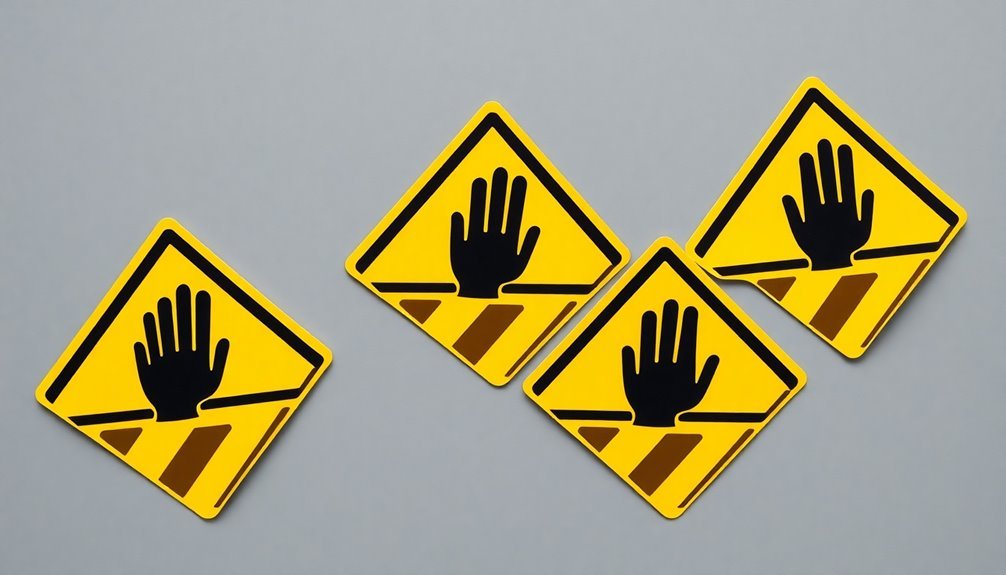
While cost-effective bulk ordering helps your bottom line, selecting the right material for your warning labels guarantees lasting performance and reliable communication in static-sensitive areas. You'll find various materials designed to withstand specific environmental challenges, from flexible vinyl with permanent adhesive to heavy-duty magnetic options that you can easily reposition.
| Material Type | Best Use Case | Key Features |
|---|---|---|
| Vinyl Labels | Outdoor Applications | UV & Chemical Resistant |
| Magnetic Backing | Movable Equipment | Repositionable & Durable |
| Semi-Gloss Paper | Indoor Signage | Cost-effective & Clear |
| Pressure-Sensitive | General Purpose | Easy Application |
When you're choosing materials for your static-sensitive warning labels, you'll need to think about several environmental factors. UV-stable inks guarantee your labels won't fade in sunlight, while chemical and moisture resistance protect against cleaning agents and humid conditions. For cleanrooms and laboratories, you'll want to select materials that won't degrade or leave residue. The pressure-sensitive options offer exceptional adhesion while remaining easy to apply, and eco-friendly alternatives are available if environmental impact is a concern for your facility.
ESD Symbols and Safety Standards
In the world of static-sensitive environments, proper ESD symbols and safety standards form your first line of defense against costly equipment damage.
You'll need to recognize and properly implement key symbols: the ESD Susceptibility Symbol (yellow hand in black triangle) for sensitive devices, and the ESD Protective Symbol for protective materials like mats and wrist straps. Remember, you can't use red in ESD symbols, as it implies personnel hazard according to ANSI/ESD S8.1.
To verify your workplace meets critical safety standards, you'll want to focus on these essential requirements:
- Comply with ANSI/ESD S20.20 and IEC 61340-5-1 standards by maintaining proper grounding systems and implementing thorough ESD control programs.
- Test your wrist straps and foot ground devices daily, while keeping humidity levels between 30% and 70%.
- Install clear signage with appropriate ESD symbols to identify protected areas and restrict access to trained personnel only.
Your ESD control measures must align with industry standards like NASA-STD-8739.7 and MIL-STD-129N. Don't forget to include text identification on ESD labels to clearly communicate necessary precautions to all personnel working in static-sensitive areas.
Creating Static-Safe Work Environments
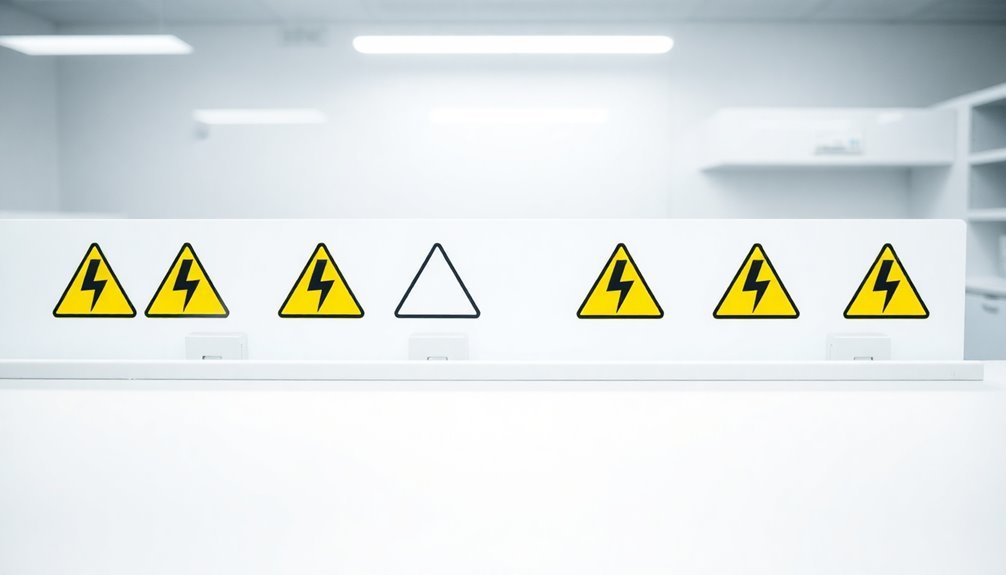
Successfully creating static-safe work environments requires a systematic approach to ESD control. You'll need to focus on proper grounding, appropriate equipment selection, and clear safety protocols to protect sensitive electronic components from damage.
Start by establishing ESD-Protected Areas (EPAs) in your workspace, clearly marking them with appropriate signage and labels. You'll want to equip these areas with ESD-safe workbenches, grounding mats, and wrist straps.
Don't forget to maintain humidity levels between 30% and 70% using appropriate control devices.
Your employees must understand proper handling techniques and ESD safety procedures. Train them to use grounding equipment correctly and maintain clean, organized workstations free from static-generating materials. Make sure they're wearing ESD-safe clothing and using the right tools for their tasks.
Implement regular maintenance checks of your ESD control measures. You'll need to test conductance regularly, verify grounding systems are working properly, and confirm ionizers are functioning effectively.
Keep detailed records of these checks and update your Standard Operating Procedures (SOPs) as needed. Remember to conduct periodic audits to identify and address any new ESD risks in your work environment.
Selecting the Right Label Size
Selecting appropriate warning label sizes for static-sensitive work areas directly impacts their visibility and effectiveness. You'll find several standard sizes that meet industry requirements while guaranteeing clear communication of static sensitivity warnings.
The most commonly used size is 1 x 2 inches, which provides enough space for essential warning text and symbols while remaining compact enough for various applications.
For more detailed warnings or when you need increased visibility, consider using larger formats like 1-3/4" x 2-1/2" or 1.5" x 3" labels. These sizes are particularly effective when warning transport carriers about static-sensitive equipment.
When selecting your label size, consider these key factors:
- The surface area available on the items or containers you're labeling
- The viewing distance from which workers need to read the warning
- The amount of information you need to display, including symbols and text
Remember to choose labels with rounded corners when possible, as they're less likely to peel and easier to apply.
If you're using automated label applicators, verify that your chosen label size matches your equipment's core and diameter specifications to guarantee smooth application.
Bulk Label Storage Best Practices
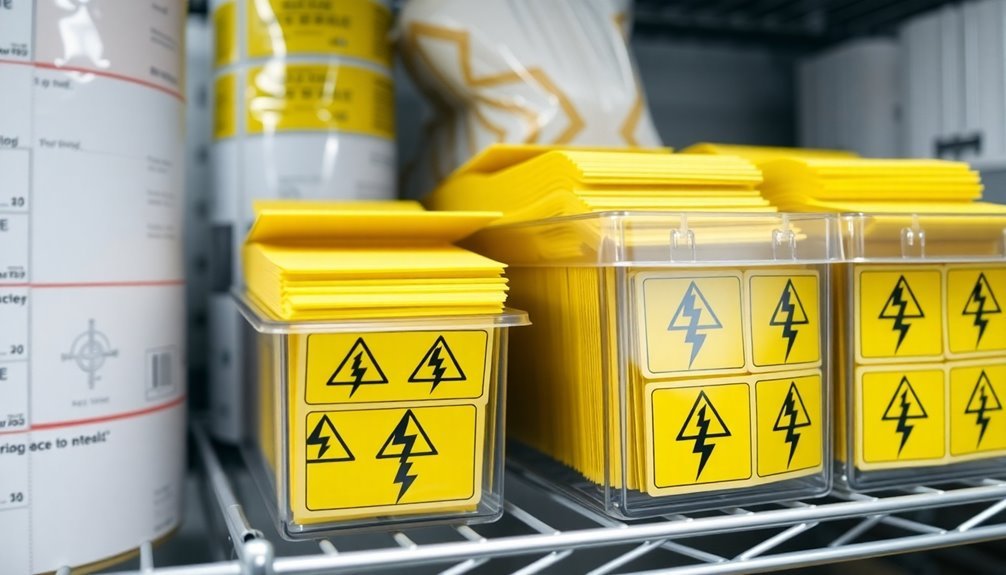
Maintaining proper storage conditions for bulk warning labels guarantees their long-term effectiveness and prevents costly replacements.
You'll need to store your labels in an environment with temperatures between 68°F and 75°F, and relative humidity levels between 40% and 50%. Keep them away from direct sunlight, heat sources, and moisture to prevent adhesive deterioration.
Always store your warning labels in their original packaging, ensuring proper sealing after each use. When handling labels, use clean hands or gloves to avoid contaminating the adhesive surface.
Don't stack or compress label rolls, as this can cause deformation and edge damage. For static-sensitive warning labels, implement anti-static measures to prevent dispensing problems and material distortion.
Implement a first-in-first-out inventory system and conduct regular inspections to check for signs of deterioration. Don't store labels directly on concrete floors, as they contain excessive moisture.
If your storage area doesn't meet the recommended conditions, you'll need to use climate control solutions. Manage your stock quantities effectively, aiming to maintain a four to six-month supply to prevent extended storage periods that could compromise label quality.
Frequently Asked Questions
How Quickly Do Warning Labels Need to Be Replaced After Exposure to Chemicals?
You'll need to replace warning labels immediately when you notice any visible damage or degradation from chemical exposure. Don't wait for specific timeframes – inspect regularly and replace labels whenever they show signs of compromise.
Can Warning Labels Be Applied in Freezing or Extremely Hot Conditions?
You'll need to apply labels at room temperature for ideal adhesion. While they can withstand extreme temperatures after application, initial installation works best between 50-90°F for proper bonding to surfaces.
Are Multilingual ESD Warning Labels Available for International Facilities?
Yes, you'll find ESD warning labels available in multiple languages to suit your international facilities. You can order standard or custom designs, and suppliers offer worldwide shipping to over 100 countries for your needs.
What Cleaning Solutions Are Safe to Use on ESD Warning Labels?
You'll want to use mild soap and water to clean your ESD warning labels. Don't use harsh chemicals or solvent-based cleaners. Apply gentle pressure with a soft, lint-free cloth and let them air dry.
How Do Humidity Levels Affect the Adhesive Properties of Warning Labels?
High humidity weakens your warning labels' adhesive strength by creating a moisture barrier. You'll notice labels curling, lifting, or completely failing to stick. It's best to maintain humidity around 50% for ideal adhesion.
In Summary
You'll save time and money by ordering ESD warning labels in bulk while ensuring consistent safety messaging across your static-sensitive work areas. Remember to choose durable materials, follow proper placement guidelines, and store extra labels correctly. By implementing standardized ESD warning labels, you're creating a safer workplace and meeting industry compliance requirements. Keep your static-control program effective with clear, visible signage throughout your facility.





Leave a Reply